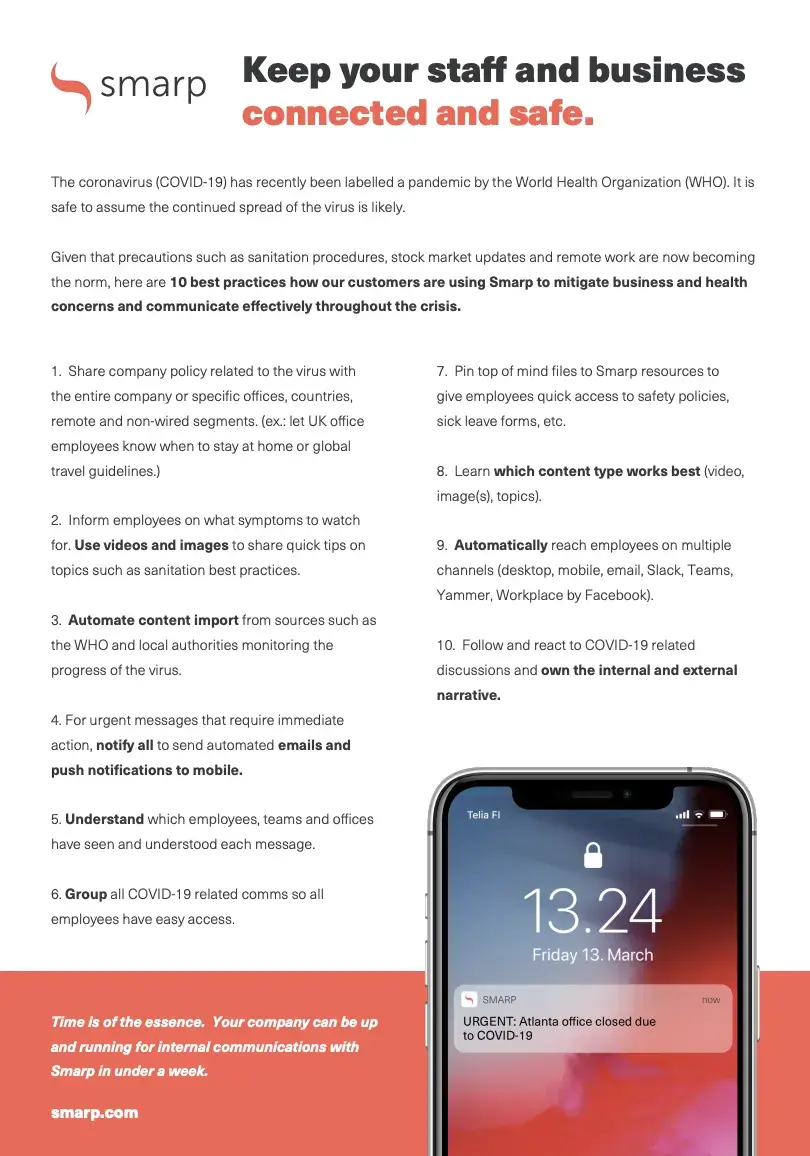The COVID-19 pandemic is disrupting the business world and companies have no choice but to review their strategies to overcome the crisis.
The global COVID-19 lockdown has unprecedented impacts on our personal and professional lives. This chaotic situation is forcing companies across the globe to rethink their business strategies.
📚Download our eBook “10 Principles of Modern Employee Communications” and learn how to communicate with the modern employee in today’s digital age.
Most business leaders have decided to launch digital transformation initiatives to keep businesses running as smoothly as possible during the COVID-19 outbreak and to better prepare for the recovery phase.
However, driving change during these chaotic and unprecedented times is challenging for both business leaders and employees.
🔎Here’s an overview of the topics we’re covering in this blog post:
A Wake-Up Call for Business Leaders to Embrace Digital Transformation
5 Reasons Why Businesses Are Accelerating their Digital Transformation Efforts Now
Digital Transformation Is a Complex Process
DX During COVID-19: Case Study
How to Communicate Change During the COVID-19 Outbreak
A Wake-Up Call for Business Leaders to Embrace Digital Transformation
You’ve probably seen the discussions going on on social media around the effect of the current pandemic on digital transformation.
One of the most popular images circling around these days is this one:

This is not a joke but the new reality of digital transformation. This current situation is significantly influencing the way companies run their business and manage their people. Business continuity today seems impossible without the right technology in place.
Even before this pandemic, 70% of companies had a digital transformation in place or were working on one. But COVID-19 is forcing companies to speed up and implement new digital transformation initiatives.
In such a rapidly evolving situation, it’s almost impossible to balance what’s best for your company, protect your employees, and still deliver a great experience to customers without the right strategy and tools.
Additionally, employers need to understand that it’s unlikely that things will get back to normal after the pandemic. Instead, we’re seeing the forced acceleration of previously slow-moving DX trends that are likely to shape the future.
Let’s now take a look into the reasons why companies are accelerating their digital transformation efforts during COVID-19.
5 Reasons Why Businesses Are Accelerating their Digital Transformation Efforts Now
The benefits of having the right digital tools in place during a crisis such as COVID-19 are obvious and significant.
As the way we do business has drastically changed in the last few months, only the companies that adapt to these changes can succeed.

Indeed, by embracing digital transformation, businesses can maintain their ability to ensure essential functions during and after the pandemic and here’s how:
1. Enhancing employee collaboration during the COVID-19 outbreak
Remote work has come, and it’s here to stay. Experts and business leaders agree that companies across the globe will keep supporting remote work even after this crisis is done.
This situation where employees are physically separated has completely changed the way our employees collaborate and work together.
The key business impact trigger will be a result of the quarantines, travel restrictions, school closures and sick family members. However, many organizations have already realized that technology can help organizations better adapt to the current changing situation.
Read on: Remote Work: 20 Ways to Engage and Connect with Your Remote Employees
As companies are launching initiatives to enhance cross-functional collaboration during the outbreak, employees are no longer expected to work cut off from one another.
Indeed, remote teams are required to be more connected, to improve their communications, and to better align their strategies. Great collaboration results in improved efficiency and increased productivity, but only if you have the right tools in the first place.
This is why we are now witnessing many digital transformation projects and the implementation of new technologies as solutions to enable better team collaboration during the outbreak.
2. Ensuring the right flow of information
In times of crisis such as the coronavirus pandemic, your internal communication should be clear, transparent, and easy to understand. What’s more, it is extremely important to be able to reach the right employees at the right time with the right message.
This is the time when employers, leaders and internal communicators should drastically improve their communication efforts.
Read on: Crisis Communication — How to Communicate Effectively with Your Employees
However, some companies have a complex internal communication ecosystem, and it often makes employees feel overwhelmed with too much or irrelevant information, confused and, often times, this results in important information being ignored by employees.

In these difficult times, it is extremely important to improve communication and collaboration across the organization. Businesses can’t afford to have employees missing out on important information such as urgent company updates or the latest changes made to projects they’re working on.
That’s why improving their internal communication is the most important digital transformation project for most of them.
With the implementation of the right employee communication technology, leaders and IC professionals are able to ensure the right flow of information in the workplace. They are able to better filter their audiences, personalize messages, send push notifications to employees’ mobile phones, and ensure that all the information is available and findable in a matter of seconds.
Below are some of our clients’ communication best practices for navigating the coronavirus crisis:

3. Maintaining employee productivity during the crisis
Most companies have made arrangements to accommodate remote working already at the beginning of the coronavirus outbreak. Indeed, their priority was to protect their employees and help reduce the spread of the virus.
Businesses are now looking for solutions to maintain employees’ productivity while working from home during the pandemic.
Many employers have realized the benefits of implementing new solutions that enable employees to stay productive and to successfully do their jobs and the ones that haven’t digitalized their internal processes earlier are now actively rethinking their strategies. They are in search for marketing, sales, development, internal communications, human resources and other tech solutions to ensure continuous business performance even during these unexpected circumstances.
These digital technologies can help improve efficiency and productivity, and make organizations more resilient to operational disruptions.
Organizations that resist embracing digital products or channels risk being disrupted during and after the crisis.
4. Enabling leaders for success
During these times, it is crucial that business leaders and managers demonstrate good leadership skills in order to increase business resilience and prepare for rebound and future growth.
Read on: Top 5 Communication Skills and How to Improve Them
However, many leaders are facing challenges that they have never experienced before. This is why digital transformation and technology departments are now working closely with leaders to help them streamline and continue effective workplace management.
Here is what we can learn from a research by Perceptyx:
1. “Feeling supported by managers in making decisions about health and well-being” is a top differentiator for employees. Those who feel supported by their managers also feel that leadership is effectively leading their organization through the pandemic.
2. The difference is dramatic — in their data, 42% of employees strongly agree that leadership is effectively leading their organization through the crisis. But among employees who feel supported by their manager in making decisions about health and well-being, almost twice as many — 71% — believe that senior leadership is effectively leading.
The same research shows that communication shapes employee perceptions about the priority the organizations place on their safety.

Moreover, when employees are extremely satisfied with communications about the company’s response to coronavirus, 96% of them believe that their employer really puts their safety first. When communication is poor, only 30% of them believe so.
It goes without saying that managers and leaders should have open discussions with employees regarding their concerns and anxieties, and express support for employees’ choices.
5. Planning for business continuity
Business leaders have to plan for post-pandemic recovery already now. They need to implement the right strategy and tools now to limit damages on their business.
“The value of digital channels, products and operations is immediately obvious to companies everywhere right now,” says Sandy Shen, Senior Director Analyst at Gartner.
“This is a wake-up call for organizations that have placed too much focus on daily operational needs at the expense of investing in digital business and long-term resilience. Businesses that can shift technology capacity and investments to digital platforms will mitigate the impact of the outbreak and keep their companies running smoothly now, and over the long term”, adds Sandy Shen.

As highlighted by Gartner in one of their latest research reports, Chief Information Officers play an important role in ensuring business continuity by planning and implementing the right digital transformation initiatives.
“When traditional channels and operations are impacted by the outbreak, the value of digital channels, products and operations become immediately obvious and CIOs can present a more convincing business case”, say Sandy Shen, Owen Chen, Julian Sun, Lily Mok, Arnold Gao and Deacon D.K Wan Gartner Analysts.
Digital Transformation Is a Complex Process
A lot of research shows that the percentage of successfully implemented digital transformation and change management efforts is pretty low.
But why? The thing is, digital transformation is a complex process.
DX includes several steps — from planning to preparation, implementation, training, and evaluation of the success of the strategy — and it involves several teams that need to align and coordinate their efforts.
Read on: Change Management: Definition, Best Practices & Examples
In some companies, change is driven by the IT leadership team while in other businesses, it’s the IT, IC, HR, finance, operations, and change management teams that are in charge.
No matter how many teams and functions are involved in the process, driving change — whether it’s the implementation of a new software or new ways of working — is going to take you time.
According to Ashley Friedlein, founder of Econsultancy:
“Digital transformation does not happen quickly. Some companies seem to expect it to happen over the course of a year. In my experience, particularly for larger organisations, closer to five years is more realistic. Even then, the task is never over”.
A survey by PMI highlights the main reasons why digital transformation projects fail and those include:
- Poor project management skills
- Poor communication in the workplace
- A lack of clear objectives
- Unfamiliar scope
- Inability to cope with new technology, mainly due to a lack of preparation and training.

It goes without saying that employers need to better understand how to communicate with their employees during the processes, how to close the skill gaps and how to better manage change in the workplace.
Even though there is no secret recipe that fits all, there are some best practices without which DX projects are unlikely to be successfully implemented.
To learn more about the must-have steps and the pillars of digital transformation, check out our guide Digital Transformation (DX): Best Practices for Driving Change.
DX During COVID-19: Case Study
It is essential that enterprise companies create the necessary operational resilience to survive this new reality. The COVID-19 pandemic has showcased the value of IT and digital transformation and organisations should use this time to accelerate the transition.
TechRadar recently presented the results of a research done by IDC about the impact of the pandemic on digital transformation.
They’ve conducted a survey in China about the opinions of 32 CXOs in 10 industries regarding the value of IT and digital transformation in the fight against the outbreak, the impact of the new coronavirus on corporate business and new digital transformation measures after the pandemic.
They had some interesting findings. The top three negative impacts of COVID-19 in enterprises were highlighted as a significant decline in sales performance, inability to resume production and an inability to visit customers.
However, the top three positive impacts cited were:
- Improved corporate ability of long-distance collaborative work,
- Gaining ability of online business development and lastly,
- Wide recognition of the value of digital transformation and information technology among all employees.
How to Communicate Change During the COVID-19 Outbreak
The pandemic is drastically changing the business world.
Companies have made remote work the new norm, they are rethinking their organizational structures, the unemployment rates are increasing at a skyrocketing rate due to the unprecedented wave of layoffs, and employees need to maintain their productivity levels while they’re coping with completely new ways of working.
Read on: The Ultimate COVID-19 Crisis Management Checklist for Employers
In these chaotic times, companies have no choice but to change the way they’re operating and they have to do it right now because let’s be honest — only businesses that are agile enough to adjust to the current situation will survive the crisis.
When done right, a digital transformation strategy usually includes the following 7 steps as explained by Eastern Peak:
- Assess the current state of digital across your organization
- Define your goals
- Outline your digital transformation roadmap
- Choose the necessary tools and technologies
- Establish clear leadership
- Set a clear and realistic budget for your DX strategy
- Empower, educate and train your staff.
We would even add one more step to the list above: step 8. Assess your digital transformation strategy and adjust it if needed.
The thing is, companies have to shorten or even skip some steps that are usually required when it comes to digital transformation.
This is why implementing change during COVID-19 is extremely challenging. Steps are skipped, and employees have to adapt to new ways of working and new technologies in no time.
Alignment across the organization plays a critical role here. Making sure that everyone is on board and understand the changes you’re implementing, why these changes are implemented very fast, why they are needed, how they’re going to impact employees’ work and how they’re going to help the business overcome the crisis is extremely important.
So, how do you get there?
The key here is your internal communication.
Proper employee communication is absolutely necessary to align your entire workplace, help employees understand the benefits behind digital transformation for both them personally and for the business overall, and drive successful digital transformation in your organization.

Broadly speaking, you need to:
- Establish a pandemic communications program.
- Have pre-approved message templates and scripts to ensure unified and aligned communication.
- Segment your audiences in order to deliver relevant and personalized messages. You should be able to target employees by their location, position, job function and other.
- Assign a spokesperson appropriate for the situation.
- Communicate regularly, clearly and openly.
- Establish an internal pandemic channel with all the important resources in one place.
- Leverage emergency mass notification services.
- Make it a two-way communication to enable your employees to speak up and to show them that you are listening to their concerns and questions.
- Measure the impact of your internal communication efforts.
Final Thoughts
In these times of crisis, companies have no choice but to review their short-term and long-term strategies. Remote work has become the new norm, and both team managers and employees have to cope with new ways of working.
During less tumultuous times, driving change takes time and effort. Remember, the implementation of a digital transformation strategy can take up to five years as explained earlier!
The key here is to communicate openly with your entire workforce. It’s the only way to ensure that 1. everyone is on board with the new strategy you’re implementing and 2. each employees knows how they can help the business survive the COVID-19 crisis.









